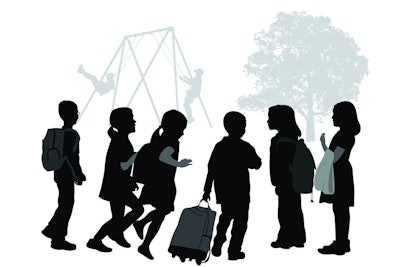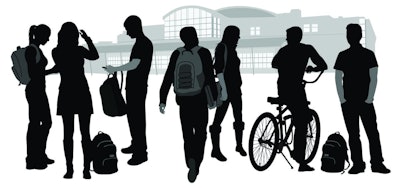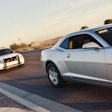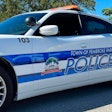 One respondent wrote it would be a good idea for officers on patrol to go to schools and periodically walk the hallways.Photo: Getty Images
One respondent wrote it would be a good idea for officers on patrol to go to schools and periodically walk the hallways.Photo: Getty Images
Last year, POLICE conducted a survey of its readers to sound out their opinions on gun control and school shootings. The survey, which was sent to more than 43,000 readers, included this open-ended question: "What measures would you take to prevent school shootings or improve response to them?" More than 1,500 self-identified law enforcement officers took the time to write an answer to that question. Here's a summation of their answers.
Threat Identification/Assessment
Many officers said they felt the most effective means of preventing school shootings is to identify people who are a threat to perpetrate such terrible acts before they actually carry them out. Conventionally, the public tends to think of mental health professionals and mental health facilities performing such threat assessments, but most officers who touted this approach to preventing school shootings acknowledged such assets are not available.
So they believe the best way to discover potential school shooters before they go active is through information from the staff and more importantly the students at the affected schools. "Students know who the dangerous people are at their schools, and they need to be encouraged to report their concerns," wrote one respondent.
Many respondents agreed with that statement. And some even suggested a nationwide hotline that students could use to report their suspicions. They envision a system that would alert both law enforcement and school administrators that the callers are fearful of possible attacks on their campuses and concerned about the behavior of other students. "We have to encourage students to say something if they see something," one respondent wrote, adding that law enforcement has to follow through on these warnings.
Harden the Targets
Some respondents wrote that school shootings are inevitable in contemporary America. They said their reasons for holding such a pessimistic view on the issue include: the free access to firearms, the lack of mental health facilities that can treat people inclined to commit such atrocities, the prevalence of violent films and video games in youth culture, the decline of morality and empathy among younger people, and the alienation that some teenagers feel in their schools.
Officers who believe that school shootings are a fact of contemporary life say one of the best ways to stop them from taking a toll is to harden the potential targets. Making the targets tougher to reach begins with access control. Respondents say the schools should reduce the number of ingress and egress points used by students and staff and set up metal detectors and video surveillance to monitor who is coming in and prevent them from bringing weapons with them. All other doors out of the school building would be emergency exits only.
 Many respondents said every school should have at least one armed SRO on campus during school hours.Photo: Getty Images
Many respondents said every school should have at least one armed SRO on campus during school hours.Photo: Getty Images
Some respondents even argue that the federal government should establish a program similar to the Transportation Security Administration (TSA) to safeguard schools. These officials would check student IDs before admitting them into the building. Such a proposal would be extremely expensive, as there are many more schools than airports, and the respondents who wrote about it admitted that drawback but said it was worth the cost.
To protect students in the event of a shooting, some respondents want to see classrooms equipped with doors that provide ballistic protection from both pistol and rifle rounds and that lock when an alarm is sounded. One respondent believed each school employee should have access to a panic button similar to the ones some people wear in their homes to alert their alarm companies if they have an emergency. The panic button would alert police in case of an incident and sound an alarm in the school, warning students and staff. Another respondent wanted schools to be equipped with drop-down barriers that would trap shooters in a single hallway when the alarm sounds and prevent them from gaining access to the rest of the school.
Arming Staff
Beyond issues of gun control, one of the most contentious arguments about school safety in America is whether training and arming staff—teachers, coaches, and administrators—would be a deterrent to school attacks or at least mitigate the body count.
POLICE asked this question in our survey. About 50% of respondents support training and arming teachers and other staff, 24% oppose it, and 26% say only staff with previous military or law enforcement training should be considered for such a program.
Arming teachers was also a popular answer to our open-ended question of how to prevent school shootings. Another popular idea was allowing armed civilian volunteers, particularly retired law enforcement and military, to patrol schools.
People who advocate arming school staff to stop school shootings generally envision giving them the right to carry handguns on campus following training. But some respondents wanted to give school employees more firepower, including rifles and pistol caliber carbines that are locked in biometric safes in the classrooms.
Currently, in some jurisdictions, even sworn school resource officers do not have easy access to long guns in the event of a school shooting. Two SROs responded to the survey and said their rifles have to be locked in their patrol vehicles in the parking lots of the schools they serve. "I can't imagine running away to my car to get my rifle should a shooter enter my building," one SRO wrote. "My school has three 100-yard hallways where I will be taking shots with my pistol, if necessary. Put gun safes in SRO offices where rifles can be accessible," the SRO recommends.
However, the SRO disagrees with the concept of arming teachers. "Just can't imagine doing that in some of our high schools. What happens if a couple of teens jump a teacher to get the gun?" Another respondent said arming teachers is not a good idea and that fighting the shooter should be left to officers. However, the respondent believes it would save lives if staff at schools were to receive first-aid training and be issued tourniquets.
Officers on Campus
It's little surprise that the single-most popular response by the readers of POLICE to the question of how to prevent school shootings and improve law enforcement response to such incidents was to put more officers in schools. Many respondents said every school should have at least one armed SRO on campus during school hours. Some said at least two SROs should be placed in every school.
Many respondents said that current SRO programs do not emphasize tactical response training for the officers. One said that all SROs should be trained to respond to active shooters according to the Department of Homeland Security Advanced Active Shooter program.
Even if SROs have active shooter response training, some respondents believe their presence at the school is not enough to deter school shootings. One respondent wrote it would be a good idea for officers on patrol to go to schools and periodically walk the hallways. Another thought locating police substations at schools would prevent school shootings.
It's unlikely that school administrators would support many of these ideas, including adding more armed officers on campus. At many schools, administrators insist on a no-gun policy for security personnel even for sworn officers. Many respondents decried such policies as naïve and dangerous for the students, the staff, and the unarmed officers and security guards.
David Griffith is editor of POLICE/PoliceMag.com.













